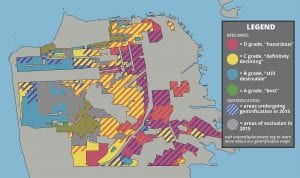By David Zisser, Senior Staff Attorney at Public Advocates
[Note: This article first appeared in ShelterForce and was adapted from the IGNITE! Community Pitch Fest, held at the Grounded Solutions Intersections 2017 conference on October 11, 2017. Out of 20 entries and six finalists, audience members chose Public Advocates’ pitch as the winner.]
Everyone deserves a stable home—a place to raise a family and build community. Unfortunately, in part because of displacement and gentrification, that stability is often elusive, especially for people of color. At Public Advocates we believe there is not only a moral basis for combatting displacement, but also a legal one—that renters’ rights are civil rights.
The Problem: Displacement
Generations of racist government policies such as redlining, the razing of neighborhoods to build highways, and exclusionary zoning created deeply segregated and unequal neighborhoods. These policies both prevented people of color from accessing resources where they lived and from moving to suburban neighborhoods where resources were being invested.
Now private developers and public agencies are finally investing in neighborhoods near transit and jobs—where many low-income communities of color have lived for generations—and as a result, are being pushed out just as resources in their neighborhoods are increasing. Landlords are forcing out longtime residents, sometimes whole buildings at a time, as they seek higher rents from wealthier populations.
The same communities of color that endured decades of disinvestment are now bearing the burden of gentrification, displacement, and resegregation. Once again, government policies are fueling this inequality, and few governments are willing to acknowledge the problem, let alone do anything to prevent it.

The problem affects communities throughout the country. In the San Francisco Bay Area in particular, about 800,000 low-income renters are at risk of displacement or are living in communities already experiencing displacement due to gentrification. Importantly, people of color are hit especially hard. In the Bay Area, as in many places, African Americans are almost twice as likely to be renters as whites and more than three times as likely to be living in poverty. In San Mateo County, African Americans and Latinos are less than 30 percent of the population, but account for more than 60 percent of total evictions.

In Oakland, African American renters are almost twice as likely to be severely rent burdened (paying at least 50 percent of income on rent) as whites, resulting in more than 37,000 African-American residents moving out of Oakland from 2000-2014—a loss of more than a quarter of the African-American population.
The instability and vulnerability caused by displacement has ripple effects, resulting in homelessness and poor health and educational outcomes.
One Solution: Be Proactive
More and more advocates and renters are arguing that protecting tenants is good policy because it advances equity, economic opportunity, and even a healthier environment. But elected officials also need to hear that protecting tenants is a legal mandate—that renters’ rights are civil rights, because displacement and gentrification are hurting some groups more than others.
The federal Fair Housing Act requires cities, counties, and states that receive federal housing funds, called “entitlement jurisdictions,” to explicitly acknowledge the racial inequality in housing and take affirmative steps to undo this historic and present injustice. This legal mandate to “affirmatively further fair housing,” or AFFH, is precisely what’s needed to address displacement.
The AFFH obligation has existed as part of the Fair Housing Act since the Act was passed in 1968, but the U.S. Department of Housing and Urban Development (HUD) only adopted a rule implementing this obligation in 2015. The rule requires entitlement jurisdictions to complete an Assessment of Fair Housing (AFH) that identifies fair housing issues and sets fair housing goals and strategies.
AFFH is a radical legal principle that requires states and local governments to proactively tackle issues that cause segregation, disproportionate housing needs, lack of access to opportunity, and lack of housing choice. Displacement checks all of these boxes:
- Displacement causes re-segregation both in communities where displacement is occurring (i.e., neighborhoods shift to become predominantly white) and in the “receiving communities” (i.e., neighborhoods become predominantly people of color).
- The pressures in the rental market that drive displacement, like increasing rents and no-cause evictions, result in disproportionate housing needs such as high rates of housing cost burden and overcrowding for protected classes.
- Displacement deprives people of color, immigrants, and families with children of the chance to live in places that are richer in resources, instead forcing them to live far from job centers and transit.
- Displacement deprives people of color of the choice to stay in their home, community, city, and region.
Making the Case
Over the last few years, Public Advocates and our allies have developed and tested this framework. We’ve worked closely with partners throughout the Bay Area to develop the concept, and have piloted it by advocating for the HUD-mandated fair housing planning documents to directly address displacement. As a result of this work, cities and counties are starting to acknowledge that because displacement disproportionately impacts communities of color, it is a civil rights issue.
Public Advocates and our allies successfully pushed Oakland, San Jose, and San MateoCounty to identify displacement as a barrier to fair housing in their AFFH planning documents. San Jose, the 10th largest city in the country, went one step further, calling out the lack of tenant protections, in particular, as an impediment, and included recommendations to expand tenant protections. Oakland, ground zero for displacement in the region, identified expanded rent control as a possible remedy. And South San Francisco committed to evaluating rent stabilization and just cause policies.
Take Action
While we hope that other local governments across the country will follow suit by defining displacement as a pressing fair housing issue and by pursuing real policy solutions, we know they are unlikely to take action without outside pressure. Here are a few actions that advocates, renters, and allies can take:
- Participate in the assessment (AFH) process to ensure that your local government identifies whether displacement is occurring and whether it is disproportionately impacting people of color, immigrants, or other protected groups. If so, it must be identified as a fair housing issue, and anti-displacement strategies must be included in the assessment.
- If your city or county doesn’t identify displacement as a fair housing issue and identify strategies to address displacement in its planning document despite your efforts, let HUD know.
- Work to ensure that your elected officials meet their AFFH duty by actually adopting strong tenant protections such as rent control, just cause eviction, anti-harassment, and right to legal counsel ordinances, as well as by taking housing off the speculative market through acquisition and rehab and first right of refusal for tenants.
- Support state legislation, like AB 686 in California, to codify AFFH at the state level, as Congress and the Trump Administration threaten to gut this mandate at the federal level.
- Join us on CarsonWatch to monitor what happens in Washington, D.C. – including potential rollbacks in federal civil rights law or enforcement – and to coordinate grassroots efforts nationally.
Let’s remind our decision makers that protecting tenants is a legal mandate, and that renters’ rights are civil rights!

